Carlisle EGA™ Suction Feed Owner's manual
- Category
- Power fine-spray systems
- Type
- Owner's manual
This manual is also suitable for

*Repair Kit No. KK-5044
(190681)
Important: Before using this equipment,
read all safety precautions and instructions.
Keep for future use.
DESCRIPTION
The EGA-503 is an external mix, touch-up
gun. The gun has a long needle taper mak-
ing detail work easy. The forefinger trigger
gives added control for delicate applica-
tion. Can be used for touch-up, shading,
edging or any type of precision painting.
Use as either suction or pressure feed
application.
Note
Wetted surfaces are stainless steel
and aluminum. Please see Warn-
ing on Page 2 regarding explosion
hazard.
SPECIFICATIONS
Air Inlet: 1/4" NPS (M)
Fluid Inlet: 1/4" NPS (M)
Type Feed: Suction or Pressure
Wetted Parts: Aluminum & Stainless Steel
P1 = Maximum Air Pressure 100 PSI (7 bar)
P2 = Maximum Fluid Pressure 10 PSI (.68 bar)
OPERATION
Prepare and strain material according to the
paint manufacturer's instructions. Attach
container to fluid inlet and tighten. Adjust
incoming air pressure to gun to achieve
desired spray results.
Note
To minimize overspray, only use as
much pressure as required to atom-
ize material.
PREVENTIVE MAINTENANCE
To clean fluid passages, remove excess
material at source, then flush with a suit-
able solvent.
To clean air cap and fluid tip, brush with a
stiff bristle brush. If necessary, use a broom
straw or toothpick. Never use a wire or hard
instrument. This may scratch or burr holes
causing a distorted spray pattern.
Note
Worn parts can cause fluid leakage.
When replacing fluid tip or fluid
needle, replace both at the same
time. Lapped sets are available.
Also replace the fluid tip gasket and
needle packing at this time.
To prevent damage to the fluid tip or
fluid needle, be sure to either 1) push
the trigger and hold while tightening
the fluid tip or 2) remove the fluid
needle adjusting screw to relieve
spring pressure.
*Government NSN No. 4940-01-182-6975
= KK-5044
Figure 1
B
A
C
D
LUBRICATION
For best results, lubricate the points indicated
in Figure 1 daily using gun lube.
A. Trigger points
B. Packings
C. Adjusting valves
D. Needle/Air valve springs
(occasionally)
EGA-503 SPRAY GUN
(SPRAY PISTOL)
EGA-503-390F
SB-2-163-R3 (4/2019) 1 / 8 www.carlisleft.com
IMPORTANT! DO NOT DESTROY
It is the Customer's responsibility to have all operators and service personnel read and understand this manual.
Contact your local DeVilbiss representative for additional copies of this manual.
READ ALL INSTRUCTIONS BEFORE OPERATING THIS DEVILBISS PRODUCT.
EN
SERVICE MANUAL

SAFETY PRECAUTIONS
This manual contains information that is important for you to know and understand. This information relates to USER SAFETY and
PREVENTING EQUIPMENT PROBLEMS. To help you recognize this information, we use the following symbols. Please pay particular
attention to these sections.
Fire
Inhaling Toxic Substances
Explosion Hazard –
Incompatible Materials
1. Adequate exhaust must be provided to keep the
air free of accumulations of flammable vapors.
2. Smoking must never be allowed in the spray area.
3. Fire extinguishing equipment must be present in
the spray area.
4. Static discharges must be prevented. Ground
(earth) all conductive objects in the spray
area, such as a cleaning solvent bucket, fire
extinguisher, etc.
5. When using solvents for cleaning:
• Those used for equipment flushing must have
a flash point equal to or higher than that of the
coating.
• Those used for general cleaning must
have flash points above 100°F (37.8°C).
1. Follow the requirements of the Safety Data Sheet
supplied by your coating manufacturer.
2. Adequate exhaust must be provided to keep the
air free of accumulations of toxic materials.
3. Use a mask or respirator whenever there is a
chance of inhaling sprayed materials. The mask
must be compatible with the material being
sprayed and its concentration.
This spray gun (spray pistol) has aluminum
passages and cannot be used with these solvents.
Aluminum is also widely used in other spray
application equipment – such as material pumps,
regulators, valves, etc. Check all other equipment
items before use. Read the label or data sheet for
the material you intend to spray. If in doubt as to
whether or not a coating or cleaning material is
compatible, contact your material supplier.
Solvents and coatings can be highly
flammable or combustible, especially
when sprayed.
Certain materials may be harmful if
inhaled or if there is contact with the
skin.
Halogenated hydrocarbon solvents,
for example" methylene chloride and
1, 1, 1, - Trichloroethane, are not
chemically compatible with the
aluminum that might be used in many
system components. The chemical
reaction caused by these solvents
reacting with aluminum can become
violent and lead to an equipment
explosion.
CAUSE SAFEGUARDSHAZARD
The following hazards may occur during the normal use of this equipment. Please read the following chart.
Important information that tells how to pre-
vent damage to equipment, or how to avoid
a situation that may cause minor injury.
NOTE
Information that you should pay special
attention to.
Important safety information – a hazard
that may cause serious injury or loss of
life.
EN
SB-2-163-R3 (4/2019)2 / 8www.carlisleft.com

SAFETY PRECAUTIONS (Continued)
CAUSE SAFEGUARDSHAZARD
Improper operation or maintenance of
equipment.
During cleaning and flushing, solvents
can be forcefully expelled from fluid
and air passages. Some solvents can
cause eye injury.
Operators should be given adequate training in
the safe use and maintenance of the equipment
(in accordance with the requirements of NFPA-33,
Chapter 15 in U.S.). Users must comply with all
local and national codes of practice and insurance
company requirements governing ventilation,
fire precautions, operation, maintenance and
housekeeping (in the U.S., these are OSHA Sections
1910.94 and 1910.107 and NFPA-33).
Wear eye protection.
General Safety
Solvent Spray
Misuse:
• All spray guns (spray pistols) project particles at high velocity and must never be aimed at any part of the body.
• Never exceed the recommended safe working pressures for any of the equipment used.
• The use of non-recommended or non-original accessories or spare parts may create hazardous conditions.
• Before dismantling the equipment for cleaning or maintenance, all pressures, air and fluid, must be isolated and released.
The disposal of waste materials must be carried out in an approved manner. Burning may generate toxic fumes. The removal or
waste solvents and coating materials should be carried out by an authorized local waste disposal service.
EN
SB-2-163-R3 (4/2019) 3 / 8 www.carlisleft.com

Ref. No. Replacement Part No. Description
Individual Parts Req.
1 EGA-4 Packing Nut 1
■ 2 --- Fluid Needle Packing 1
3 EGA-7 Baffle 1
4 EGA-4000-F Tip, Needle & Gasket (includes 4, 5, 15) 1
■ 5 EGA-59-K5 Gasket (Kit of 5) 1
6 EGA-443 Trigger and Stud Assy. 1
■ 7 AG-3-1-K5 Trigger Bearing Stud (Kit of 5) 1
8 EGA-40-390 Air Cap 1
9 EGA-11 Retaining Ring 1
10 EGA-454 Fan Adjusting Assembly 1
■ 11 SSG-8205-K10 O-Ring (Kit of 10) 1
■ 12 AG-26-K10 Washer (Kit of 10) 2
■ 13 --- Spring 1
14 EGA-3 Packing Gland 1
15 --- Fluid Needle (included with Item 4) 1
■ 16 AG-7-K5 Needle Spring Kit (Kit of 5) 1
17 AG-16 Fluid Needle Adjusting Screw 1
18 EGA-441 Air Valve Assy. 1
19 AG-46-K3 Lock Nut (Kit of 3) 1
■ 20 EGA-9-K5 Stem (Kit of 5) 1
■ 21 SST-3008 Ball 1
■ 22 C-104 Spring 1
23 GD-36 Spring Retainer 1
■ 24 EGA-5-K6 Air Valve Plunger (Kit of 6) 1
1
■ A quantity of necessary parts is included in Gun Repair Kit KK-5044. Government NSN No. 4940-01-182-6975 = KK-5044.
Suffixes -K3, -K5, etc. designates kits of multiple parts. Example: EGA-59-K5 is a kit of (5) gaskets.
PARTS LIST
20
19
21
22
23
18
Fluid Inlet
1/4" NPS(M)
Air Inlet
1/4" NPS(M)
2
4
5
9
8
6
7
24
10
12
11
12
13
14
15
16
17
3
EN
SB-2-163-R3 (4/2019)4 / 8www.carlisleft.com

TROUBLESHOOTING
CONDITION CAUSE CORRECTION
Heavy top or bottom Horn holes plugged. Clean. Ream with non-metallic point.
pattern Obstruction on top or bottom of fluid tip. Clean.
Cap and/or tip seat dirty. Clean.
Heavy right or left side pattern Left or right side horn holes plugged. Clean. Ream with non-metallic point.
Dirt on left or right side of fluid tip. Clean.
Remedies for top-heavy, bottom-heavy, right-heavy and left-heavy patterns:
1) Determine if obstruction is on cap or fluid tip. Do this by making a test pattern. Then, rotate cap one-half
turn and spray another pattern. If defect is inverted, obstruction is on air cap. Clean air cap as
previously instructed.
2) If defect is not inverted, it is on fluid tip. Check for a fine burr on edge of fluid tip. Remove with #600
wet or dry sand paper.
3) Check for dried material just inside opening. Remove by cleaning.
Heavy center pattern Material flow exceeds air cap’s capacity. Thin or lower fluid flow.
Atomizing pressure too low. Increase pressure.
Material too thick. Thin to proper consistency.
Split spray pattern Fluid adjusting knob turned in too far. Back out counterclockwise to achieve proper flow.
Insufficient material flow. Increase fluid presssure (pressure feed).
Atomization air pressure too high. Reduce air pressure.
Too much fan air. Turn fan adjust in to reduce.
Jerky or fluttering spray Loose or damaged fluid tip/seat.* Tighten or replace.
Material level too low. Refill.
Container tipped too far. Hold more upright.
Obstruction in fluid passage. Clean.
Loose or broken fluid tube or fluid inlet nipple. Tighten or replace.
Dry or loose needle packing nut. Lubricate or tighten.
Will not spray No air pressure at gun. Check air supply and air lines.
Needle adjusting screw not open enough. Open needle adjusting screw.
Excessive overspray Too much atomization air pressure. Reduce pressure.
(spray mist) Gun too far from work surface. Adjust to proper distance.
Improper stroking (arching, gun motion too fast). Move at moderate pace, parallel to work surface.
Dry Spray Air pressure too high. Decrease air pressure.
Gun tip too far from work surface. Adjust to proper distance.
Gun motion too fast. Slow down.
Gun out of adjustment. Adjust.
Fluid leaking from packing nut Packing nut loose. Tighten, do not bind needle.
Packing worn or dry. Replace or lubricate.
Fluid leaking or dripping from Foreign matter in tip.* Clean.
front of gun Packing nut too tight. Adjust.
Dry packing. Lubricate.
Fluid tip or needle worn or damaged. Replace tip & needle with lapped set.
Needle spring deformed or broken. Replace.
Runs and sags Too much material flow. Adjust gun or reduce fluid pressure.
Material too thin. Mix properly or apply light coats.
Gun tilted on an angle. Hold gun at right angle to work and adapt to
proper gun technique.
Thin, sandy coarse finish, Gun too far from surface. Check distance. Normally 6-8" (152-203 mm).
drying before it flows out Too much air pressure. Reduce air pressure and check spray pattern.
Improper thinner being used. Follow paint mfg's mixing instructions.
Thick, dimpled finish “orange peel” Gun too close to surface. Check distance. Normally 6-8" (152-203 mm).
Too much material coarsely atomized Air pressure too low, or too much material. Increase air pressure or reduce fluid pressure.
Improper thinner being used. Follow paint manufacturer’s mixing instructions.
Material not properly mixed. Follow paint manufacturer’s mixing instructions.
Surface rough, oily, dirty. Properly clean and prepare.
Excessive fog Too much, or too fast-drying thinner. Remix properly.
Too much atomization air pressure. Reduce pressure.
Unable to get round spray Fan adjustment screw not seating right. Clean or replace.
Air cap retaining ring (nut) loose. Tighten.
* Most common problem.
EN
SB-2-163-R3 (4/2019) 5 / 8 www.carlisleft.com

GUN LUBE
SSL-10
2 oz. (60 ml) bottle
(Automotive Refinish)
SSL-10-K12
2 oz. (60 ml) bottle
(Industrial Finishing)
TGS-503 Cup
ACCESSORIES
P-H-5516 AIR ADJUST-
ING VALVE
WR-103 WRENCH
Contains all necessary
tip, hose and nut sizes
used on or with gun.
Available in U.S. only.
8 ounce (240 ml) poly-
ethylene suction cup.
Compatible with all paint
materials: contains no
silicone or petroleum
distillates to contaminate
paint.
Enables user to control
and reduce air usage at
the gun. Ideal for low
pressure spraying.
42884-214-K5 3/8"
42884-215-K10 5/8"
CLEANING BRUSHES
These brushes are help-
ful in cleaning threads
and recesses of gun
body. Available in U.S.
only.
HAV-500 or HAV-501
Air Adjusting Valve
(HAV-501 shown)
HAV-500 does not have
pressure gauge. Use to
control air usage at gun
HARG-510 Air Regula-
tor
Use to maintain nearly
constant outlet pres-
sure despite changes
in inlet pressure and
downstream flow.
Millennium 3000
Twin Cartridge
Paint Spray Respirator
NIOSH-Certified, for
respiratory protection
in atmospheres not
immediately dangerous
to life.
29-3100 Scrubs
®
Hand
Cleaner Towels
(Industrial Finishing)
Scrubs
®
are a pre-moistened hand cleaner towel for
painters. No water is needed.
192218 Scrubs
®
Hand Cleaner Towels
(Automotive Refinish)
Contains six precision tools designed to effec-
tively clean all DeVilbiss, Finishline and other brand
spray guns.
192212 Professional Spray Gun Cleaning Kit
KK-5060 Air Cap Clean-
ing Kit
Consists of: 2 brushes,
1 wire pick. Helps
keep air cap clean and
performing properly.
EN
SB-2-163-R3 (4/2019)6 / 8www.carlisleft.com

NOTES
EN
SB-2-163-R3 (4/2019) 7 / 8 www.carlisleft.com

EN
SB-2-163-R3 (4/2019)8 / 8www.carlisleft.com
WARRANTY POLICY
This product is covered by Carlisle Fluid Technologies’ materials and workmanship limited warranty.
The use of any parts or accessories, from a source other than Carlisle Fluid Technologies,
will void all warranties. Failure to reasonably follow any maintenance guidance provided
may invalidate any warranty.
For specic warranty information please contact Carlisle Fluid Technologies.
For technical assistance or to locate an authorized distributor,
contact one of our international sales and customer support locations.
Region Industrial/Automotive Automotive Renishing
Americas
Tel: 1-800-992-4657 Tel: 1-800-445-3988
Fax: 1-888-246-5732 Fax: 1-800-445-6643
Europe, Africa,
Middle East, India
Tel: +44 (0)1202 571 111
Fax: +44 (0)1202 573 488
China
Tel: +8621-3373 0108
Fax: +8621-3373 0308
Japan
Tel: +81 45 785 6421
Fax: +81 45 785 6517
Australia
Tel: +61 (0) 2 8525 7555
Fax: +61 (0) 2 8525 7575
Carlisle Fluid Technologies is a global leader in innovative nishing technologies.
Carlisle Fluid Technologies reserves the right to modify equipment specications without prior notice.
DeVilbiss
®
, Ransburg
®
, ms
®
, BGK
®
, and Binks
®
are registered trademarks of Carlisle Fluid Technologies, Inc.
©2019 Carlisle Fluid Technologies, Inc.
All rights reserved.
For the latest information about our products, visit www.carlisleft.com
-
 1
1
-
 2
2
-
 3
3
-
 4
4
-
 5
5
-
 6
6
-
 7
7
-
 8
8
Carlisle EGA™ Suction Feed Owner's manual
- Category
- Power fine-spray systems
- Type
- Owner's manual
- This manual is also suitable for
Ask a question and I''ll find the answer in the document
Finding information in a document is now easier with AI
Related papers
-
Carlisle EGHV-531 HVLP Gun Owner's manual
-
Carlisle Trophy Series Owner's manual
-
Carlisle Model 2100 Spray Gun Owner's manual
-
Carlisle Ransburg BINKS - CCV Valves User manual
-
Carlisle BINKS Steadi-Grip User manual
-
Carlisle 95APF Gun Owner's manual
-
Carlisle Trophy AA1600 & AA4400 Owner's manual
-
Carlisle Compact TT Pres/Siphon Owner's manual
-
Carlisle Compact HVLP Owner's manual
-
Carlisle Compact HVLP Gun Owner's manual
Other documents
-
Husky H4910DSG User manual
-
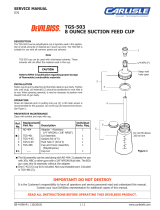 DeVilbiss Suction Feed Cups User manual
DeVilbiss Suction Feed Cups User manual
-
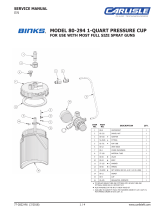 Binks Cups & Accessories User manual
Binks Cups & Accessories User manual
-
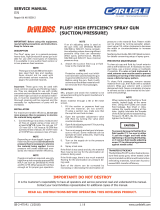 DeVilbiss PLUS® Pressure Feed User manual
DeVilbiss PLUS® Pressure Feed User manual
-
 DeVilbiss PLUS® Gravity User manual
DeVilbiss PLUS® Gravity User manual
-
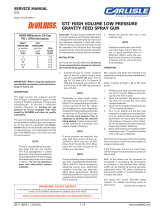 DeVilbiss GTi® Gravity User manual
DeVilbiss GTi® Gravity User manual
-
 DeVilbiss JGA® Pressure Feed User manual
DeVilbiss JGA® Pressure Feed User manual
-
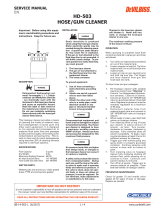 Binks Hose/Gun Cleaner & Strainers User manual
Binks Hose/Gun Cleaner & Strainers User manual
-
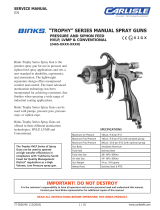 Binks Trophy Series Owner's manual
Binks Trophy Series Owner's manual
-
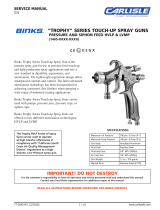 Binks Trophy Series User manual
Binks Trophy Series User manual
















